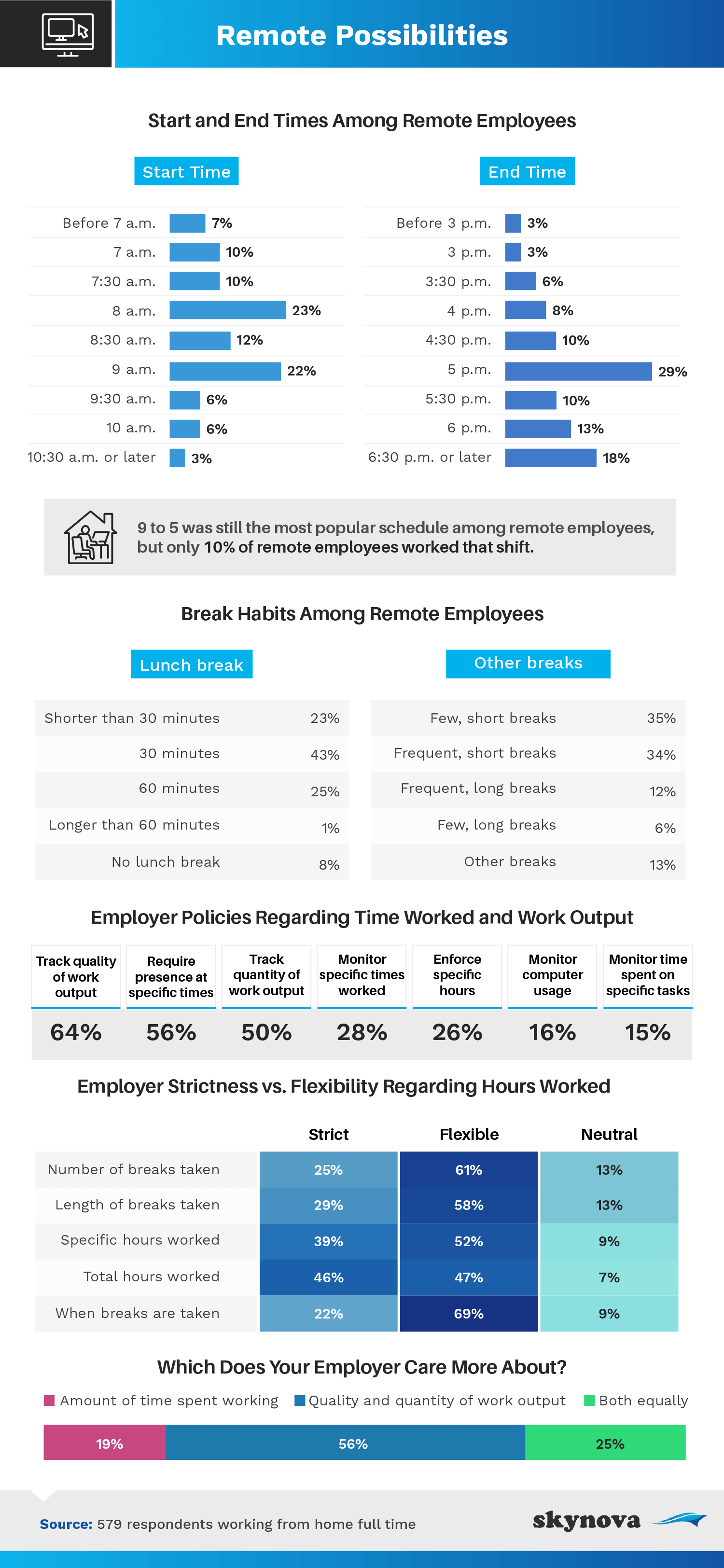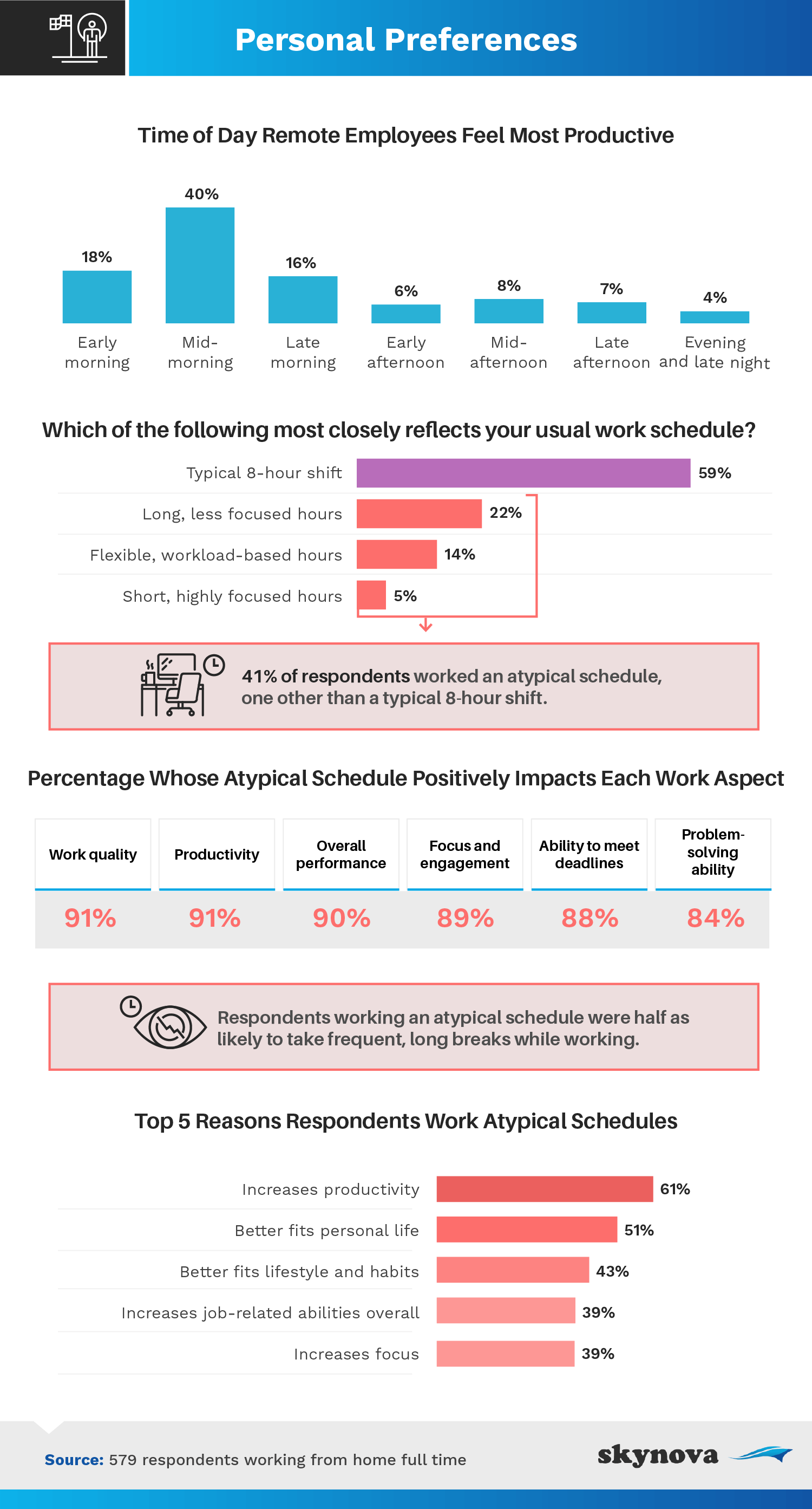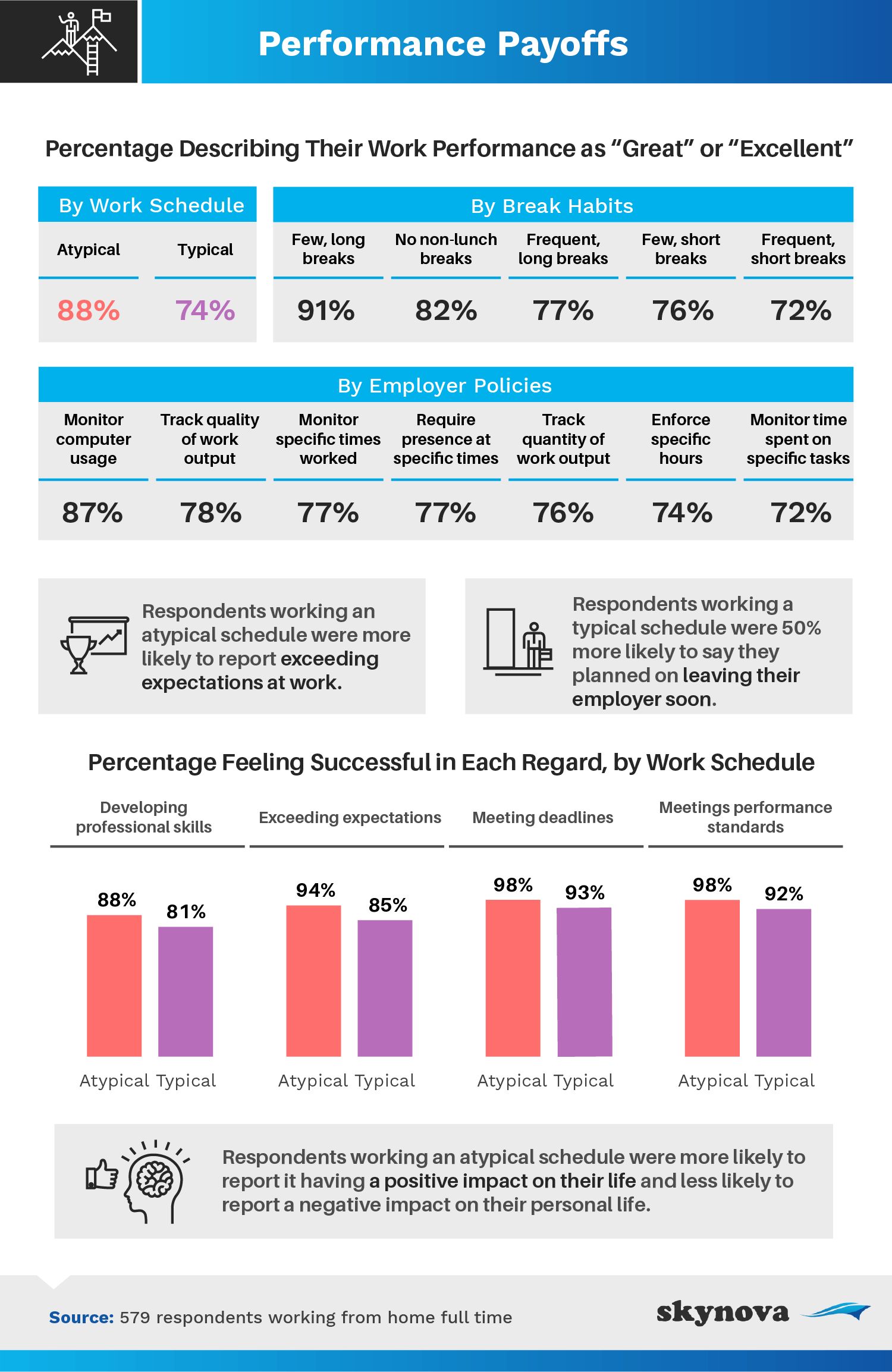
|
For millions of Americans, the sudden shift to working remotely at the start of the COVID-19 pandemic may have come as a shock. For many who weren’t accustomed to remote work, the changes in daily routine, communication, and work-life balance created new, unexpected challenges that may have taken weeks or months to overcome.
Compounded with the isolation of social distancing and the uniquely individual level of distractions at home, the “new normal” may have felt like it couldn’t end soon enough. Instead, many businesses are adopting a work-from-home model for the foreseeable future, and working Americans are learning how to adjust their schedules to maximize productivity wherever possible.
To understand how much of an impact remote work has had on employees and how the standard workday may be permanently changing, we surveyed over 575 people working from home full time. Read on as we explore what time most people are starting and ending their workdays, when they believe they’re most productive, and how many businesses are allowing their employees to have flexible schedules rather than the typical “company standard.”
One of the biggest struggles for working remotely during the pandemic has been establishing an effective work-life balance. With so many families sharing a space for remote work and distance learning, setting a schedule that works for you and your family can help you maximize productivity at home.

Among the 579 full-time remote employees we surveyed, just 10% reported working traditional 9 to 5 hours. Instead, we found the workday was starting before 7 a.m. for some, and ending after 6:30 p.m. for others. Most commonly, employees indicated starting their workday at 8 a.m. (23%), followed by 9 a.m. (22%) and either 7 a.m. or 7:30 a.m. (10% each). Ending their days, most people reported signing off at 5 p.m. (29%), followed by some after 6:30 p.m. (18%), 6 p.m. (13%), and 4:30 or 5:30 p.m. (10% each).
It can be easy to overlook daily breaks when you’re working from home, but experts say even a short time away from your desk or workstation can help you feel more motivated throughout the day and more creative when you log back on. Forty-three percent of people working remotely reported taking 30-minute lunch breaks, while others took a full hour (25%), and some took less than 30 minutes (23%). Just 8% of remote employees indicated routinely not taking lunch at all. Thirty-five percent of employees also took a few short breaks throughout the day, and more than 1 in 3 took frequent short breaks.
Just 26% of employees indicated their jobs enforced specific hours while they were working remotely and more commonly tracked work quality or output (64%) or required presence at specific times (56%). Twenty-eight percent of respondents said their jobs monitor specific times worked.
A majority of people also indicated their jobs offered flexibility around when and how they took their breaks. Sixty-nine percent reported having flexibility around when to take breaks, while 61% said policy dictated the number of breaks allowed (61%), the length of their breaks (58%), and the specific hours they worked (52%). More than the amount of time spent working (19%), 56% of employees polled believed their employer most cared about the quality and quantity of work they produce.
Establishing a flexible work schedule in the office may be challenging, but allowing employees working remotely the opportunity to be more flexible with the hours they work can increase both their productivity and work-life balance.

While midmorning was most commonly identified as the most productive time of day for 40% of people working remotely, we found respondents identified everything from early morning (18%) to evening and late night hours (4%) as the best time of day to get work done. Despite the perception that the early or midmorning hours should be your opportunity to get things done, it’s important to recognize your own life patterns and energy levels and plan your work moments (and breaks) accordingly to maximize productivity.
Fifty-nine percent of remote employees indicated working a typical 8-hour shift, though 22% said they work a longer, albeit less focused, shift, and 14% worked flexible hours based on each day’s demands. Among the more than 2 in 5 remote employees working an atypical schedule (not an 8-hour shift), we found the most common benefits to be increased work quality (91%), productivity (91%), performance (90%), and focus and engagement (89%).
Full-time remote employees not working a conventional 8-hour shift were also half as likely to report taking long, frequent breaks throughout the day. Sixty-one percent of respondents said their atypical work schedule allowed them to be more productive, followed by those who said it fit better with their personal life (51%) or their lifestyle and habits (43%).
According to our survey, letting employees take more personal control over their work schedules doesn’t just help bolster their productivity, but it may be indicative of a more successful work culture that promotes development and encourages higher quality performances.

Allowing teams the opportunity to create more flexible working schedules won’t just make them feel more productive, it can help them feel more positive about the quality of work they produce. Compared to 74% of respondents working a conventional work schedule, 88% of those working a more flexible schedule described their work performance as great or excellent. Rather than taking frequent, short breaks, we found employees taking a few long breaks (91%) or no additional breaks beyond their lunch (82%) were the most likely to report great or excellent work performance.
Flexible schedules for remote employees may be an indicator of a more positive work culture that pays off in both increased overall productivity and quality of work teams produce. Respondents were more likely to indicate great or excellent work performance when employers tracked quality of work rather than monitoring time worked and were generally less likely to feel this way when their jobs enforced specific schedules. Additionally, remote employees working an atypical schedule were more likely to say they exceeded expectations at work, met deadlines, and developed professional skills. In contrast, those working a conventional work schedule were 50% more likely to say they were planning to leave their jobs in the future.
Adjusting to working remotely has presented a number of challenges for millions of Americans adapting to new rhythms and routines. As we found, helping teams create a balance for their overlapping work and home lives may be as simple as allowing them more flexibility with the hours they work.
Rather than requiring they adhere to a typical 8-hour schedule, people we polled working atypical schedules, sometimes logging on earlier or later and logging off accordingly, were more likely to report increased levels of productivity, better work performance, and more energy. Accommodating schedules that work better for employees’ home lives and help them feel more productive doesn’t just fit better with their lifestyle or habits, it can make them feel happier with their jobs and less likely to look for employment elsewhere.
Skynova is an online invoicing solution designed specifically for small businesses to help them look more professional, get paid faster, bill from anywhere at any time of day, and stay organized in the process. With 37 unique software modules that can be used together or separately, Skynova offers better control of invoicing, accounting, retainers, work orders, and more. In addition to these solutions, Skynova also produces reports like this one to help illuminate growing trends in the workplace business owners need to know about.
For this study, we surveyed 579 respondents who worked from home full-time. Among those respondents, 287 were male, 289 were female, and three did not identify as male or female. Our respondents ranged in age from 18 to 83 with an average age of 37.
To help gather accurate responses, all respondents were required to identify and correctly respond to a decoyed attention-check question. In some cases, questions and answers have been rephrased for clarity or brevity. These data rely on self-reporting. Potential issues with self-reported data include, but are not limited to, telescoping, selective memory, and attribution errors.
Are your readers struggling to adapt to their remote environments? We encourage you to share the results of this study for any noncommercial use with the inclusion of a link back to this page in your story as credit to our team of contributors for their work.